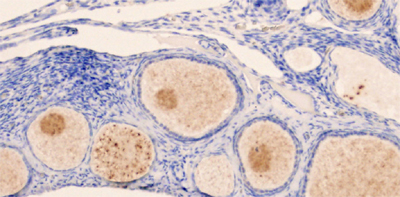| RIKEN Center for Developmental Biology (CDB) 2-2-3 Minatojima minamimachi, Chuo-ku, Kobe 650-0047, Japan |
December 15, 2008 – The placental cells that emerge from trophectoderm early in mammalian development are crucial to sustaining the embryo, and represent an important evolutionary novelty specific to mammals. While eutherians, or true mammals, have the most highly developed placenta, metatherians (marsupials) and even prototherians (monotremes, or egg-laying mammals) develop primitive cells that nourish the early embryo as well. Despite the central importance of this maternal feature, however, little is know about the evolutionary origins of the placenta. New work by Team Leader Hitoshi Niwa and colleagues from the Laboratory for Pluripotent Cell Studies has shed fresh light onto this problem, demonstrating a link between evolution at the molecular level and the advent of trophectodermal differentiation. In an article published in Evolution & Development, Niwa and his collaborators from the University of Adelaide (Australia) show that a gene duplication event that resulted in the functional specialization of the gene Pou5f1 (also known as Oct3/4), which plays a vital role in pluripotency as well as the earliest differentiation event in mammalian embryogenesis, trophectoderm specification.
Recent work in the sequencing of many vertebrate genomes (including the recent completion of the platypus and opossum genomes) has opened up a wealth of opportunities to mine and compare genomic features across taxa. Knowing the importance of the POU family of genes, particularly a vertebrate–specific subset known as class V (of which Pou5f1 is a member), the team began by searching multiple genomes to look for possible relationships. Previous work had shown that non-mammalian vertebrates, such as fish, amphibians and birds all contained at least class V POU gene, which had been assumed to be simply homologous to Pou5f1 in eutherians mammals. But interestingly, they found that transitional mammals such as monotremes and marsupials had two copies of such genes, suggesting that the homology between Pou5f1 and non-mammalian vertebrate POU genes is paralogous (meaning the result of a gene duplication event), rather than orthologous (meaning the outcome of changes in speciation). Intrigued by the apparent duplication of POU genes early in the mammalian lineage, Niwa next looked at the function of the platypus Pou5f1 gene. Using a functional complementation assay, the team tested whether platypus Pou5f1 would be able to substitute for the native gene in mouse ES cells from which it had been deleted. Surprisingly, the test showed that the platypus gene was functionally equivalent, rescuing self-renewal in the knockout ES cells. Studying Pou5f1 at the gene sequence level, the team found that a number of regulatory elements conserved among mammals are also seen in the platypus gene, but that an important autoregulatory region is absent. As a consequence, platypus Pou5f1 fails to establish the reciprocal inhibition of Cdx2, a genetic hallmark of eutherian development necessary for the segregation of trophectoderm from embryo proper only a few days after fertilization. “What we found here was a case of gene duplication leading to an important new function,” says Niwa. “But perhaps even more interestingly, the differences in function between the platypus and eutherian Pou5f1 seem to be more a factor of differences in gene regulation, rather than differences in the gene itself, which provides more evidence of the great subtlety of the evolutionary process.” |
||||||
|
||||||
 |
| Copyright (C) CENTER FOR DEVELOPMENTAL BIOLOGY All rights reserved. |
